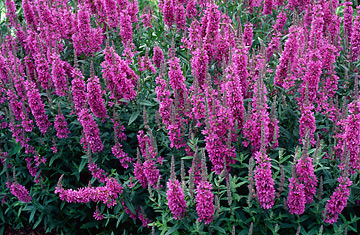
Purple Loosestrife
If you thought composting your organic waste and planting greenery in your garden were enough to earn you a gold star in environmental responsibility, think again. Those sweet-smelling blooms in your backyard patch may brighten the yard, but they could actually be doing much more harm than good to the local ecosystem.
Known as invasive non-indigenous species, such garden mainstays as garlic mustard or Japanese barberry are often cultivated for their beauty and hardiness. Green-thumbed Americans spend $9 billion a year on plants, flowers and trees, but what so many avid gardeners don't know is that by introducing an unfamiliar species to their local topography, they could be triggering a domino effect of significant environmental damage. Though most of the thousands of non-indigenous plants on the market are harmless, the few varieties that cause trouble have sprouted in every corner of the U.S. landscape.
Kudzu is a flowering, ropelike vine, first introduced from Asia in 1876. The U.S. Soil Conservation Service once paid farmers to plant it to stop erosion; now kudzu rampages across large swaths of the South, strangling and killing trees and all other plant life in its wake. Benign-looking cheatgrass carpets the shrub-steppes of the West and feeds some grazing species and birds. But it's also explosive kindling that increases the frequency and intensity of wild forest fires. Drive along any U.S. highway and you'll likely catch sight of purple loosestrife's telltale slender stalks and magenta flowers. Brought over from Europe in the 19th century as an ornamental plant, it flourishes in ditches and marshes in 48 states and costs the American government $45 million a year in eradication efforts. Left uncontrolled, purple loosestrife grows aggressively and chokes the life from wetlands and marshes, reducing populations of indigenous insects, amphibians, songbirds and fish.
"Invasive plants are one of the greatest ecological problems we are facing right now," says W. Gary Smith, a landscape architect based in Austin. "My public enemy number one is the Norway maple." Popular for providing shade in yards across the Northeast, the Norway maple grows up to 30 ft. high in 23 U.S. states. New Hampshire classifies it as a noxious weed; selling or transporting it is illegal, and fines for doing so can range from $250 to $500 per plant.
"The only tree capable of growing in the shade of a Norway maple is another Norway maple," Smith says. It tends to crowd other plants out of their natural habitats and the result is a monoculture forest — only one kind of tree as far as the eye can see. The result is a sicker, less beautiful forest (the leaves of the Norway maple, for example, don't turn brilliant colors in the fall, like other types of native maples) that alters the diversity of the natural food chain and harms local wildlife.
According to Smith, the regions of the country where invasive plant species are most widespread are those under the most pressure to develop, such as suburban communities, summer vacation spots or natural-resource extraction sites. Like a body with a weak immune system, Smith says, "An ecosystem under stress is ripe for invasion by non-native plants."
So, how can we weed out the killer vegetation? One nursery, Bailey's, based in Newport, Minn., has turned to the lab. One of the country's largest wholesale chains, Bailey's has partnered with scientists at the University of Minnesota and the University of Georgia to design hybrid plants that would eventually take the place of invasive species. The company already sells hybrids that flower longer and smaller (to accommodate cramped outdoor spaces) and have richer color, but it hopes to create new breeds engineered for sterility that way, the garden blooms won't bud anywhere but in your backyard.
In 2004, the Nature Conservancy approached a San Francisco nonprofit environmental organization called Sustainable Conservation to spearhead an action plan to combat invasives in California, one of the hardest hit states in the nation. Bringing together environmentalists, ecologists, government agencies and professional horticulturists, along with representatives from industry, the group formulated PlantRight, an educational program designed to promote phasing out the use of destructive species and encourage planting of local varieties. Recognizing the value of a voluntary program — something that many other states failed to do — PlantRight doesn't call for outright statewide bans of any invasive species. Instead it makes recommendations based on climatic zones and acknowledges that plants that are harmful to California's coastal region may be perfectly suitable, say, to its deserts.
By starting educational campaigns at the industry level now and holding off on public appeals until 2008 PlantRight's aim is to prepare nurseries well ahead of the anticipated consumer demand for regional plants. Project manager Terry Kempton says her program is indeed viewed as "more of a support to the industry and not a threat," which bolsters participation.
In the meantime, individual gardeners need to become educated consumers. Landscape architect Smith suggests that you begin by checking the U.S. Dept. of Agriculture website for state-by-state listings of invasives. He also recommends that you do your research before you buy: "If you ask trained horticultural staff about local alternatives to invasive species and they can't answer your questions, go elsewhere."
